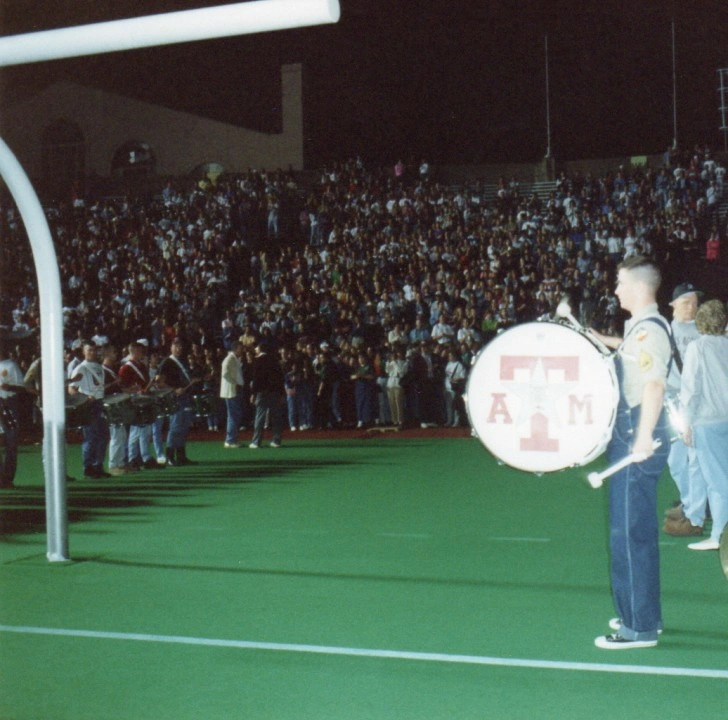I am a proud Texas Aggie, as was my father before me and is my son. Once the blood takes on that maroon hue, there’s no returning to a sense of normalcy. One of the many things that distinguish Texas A&M is the rich panoply of traditions that infuse every aspect of daily life. Some of the traditions are quirky, like the mystical numerology of your class year. Some of the traditions are incredibly profound, like Muster or Silver Taps.
The picture above is of me as a student at my fourth favorite tradition, Midnight Yell. I’m the handsome young lad with the bass drum hanging off his chest (an endeavor which has funded my chiropractor’s new boat) standing at the north end of Kyle Field during Midnight Yell. This is a tradition where twenty or thirty thousand Aggies gather at midnight the night before a football game to practice our yells (Aggies don’t “cheer” … we yell).
Tradition holds an important and powerful place in the human experience. It is a way of passing down accumulated knowledge and connecting a thread through generations of humanity. There are traditions that bind, traditions that teach, traditions that empower, and traditions that celebrate. Traditions are an important part of humanity and should be respected as such, but that does not mean that they should be slavishly perpetuated. There’s an old joke at A&M that once somebody does something three times, it’s a tradition. That’s how a lot of ‘less than brilliant’ traditions get their start. When I think back to some of the traditions from my student days, it gives my stomach a whirl.
It’s the same feeling I get when I hear the phrase “like for like.”
When people are evaluating new CX platforms to replace their current ones, too many times they resort to looking for “like for like.” They want to replace their current technology with new technology, but they want the new technology to work just like the old technology. Why do we do this to ourselves?
Largely, the desire for “life for like” is rooted in fear and ignorance. Those two words are loaded with negative connotations but take them literally. Replacing a CX platform is no small endeavor. People are rightfully fearful that they will break something important. The existing CX platform is the final manifestation of years of organizational evolution and investment. It has been tweaked and tuned to the point that it is so integral to the company corpus that one risks career suicide to try to reinvent it. Right? Tradition!
Meanwhile, the people who are charged with finding a replacement for the existing CX platform are often experts at what they have, but relatively ignorant of what other CX platforms do. Why wouldn’t they be? Unless they have worked on other platforms at other organizations, most seasoned CX professionals have spent their entire careers working with one or two core technologies.
Taken together, the fear of messing up a good thing coupled with the ignorance of what can be done results in the safety position of “like for like.”
“at the end of the day… if it does the same thing, what was the point?”
I would argue that “like for like” is not safe at all. In fact, it is the most dangerous position of all. Imagine that you spend months of discovery; commit thousands of hours of internal time evaluating new platforms; send millions of dollars buying the chosen platform; disrupt the organization for months while deploying the new platform; commit even more hours of internal time to the project to install the new platform; and at the end of the day… it does the same thing. What was the point?
While a “like for like” installation perpetuates the status quo… it perpetuates the status quo.
What we tend to forget when seeking a “like for like” replacement is that while the existing platform represents the accumulated knowledge of the organization, it also represents the accumulated constraints, concessions, and mistakes of the organization. Those constraints are different with a new platform; we need to reevaluate any concessions, and we don’t want to perpetuate the mistakes.
Here is my suggestion… whenever you hear yourself asking how the old platform works or find yourself at a loss to explain why something works the way it does (this is just how it has always worked), stop. Start with the question, “what do we want it to do in order to achieve our stated business objectives?” Align to a North Star and focus all effort on that direction. We may still need to figure out something on the old platform or reverse engineer a function, but at least we are doing it for the right reason and not just to perpetuate the norm.
Once you have chosen a platform (with an expert CX engagement service provider like Waterfield Tech), don’t try to do it all at once. You will fail. The old platform got to where it was after years of iterative innovation. The new platform is going to get there the same way. Start with Minimum Valuable Product (what do we HAVE to do), get the platform activated, and then use the insight derived from your new modern platform to drive informed innovation. The pace of innovation in modern CX Cloud platforms is extremely fast. You need insight to see where you are going.
Tradition is important, but the higher tradition to which we should adhere is the tradition of giving our customers an exceptional experience with the best tools available.
About the Author

Owen Robinson
VP of CX Strategy
Waterfield Tech
Owen is responsible for leading Waterfield’s world-class CX organization and go-to-market strategy. He has spent over 20 years crafting differentiated customer experiences at scale for some of the most innovative companies on the planet and has deep experience in leading brilliant people who evolve Cloud CX and WEM platforms.


